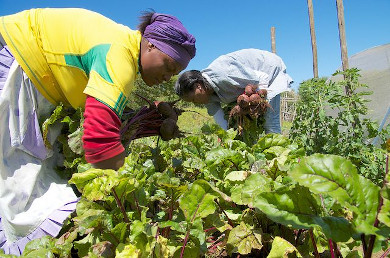14.1 Introduction
|
Previous
13.8 Chapter summary
|
Next
14.2 Nutrients
|
Chapter 14: The chemical industry
14.1 Introduction (ESCRV)
This section studies the use of resources, more specifically phosphate rock, natural gas and other gases (like nitrogen and oxygen) to produce fertilisers to sustain a food supply for people on Earth. The industrial processes that are involved in the manufacturing of fertilisers are studied. The purpose of studying this industry is to make learners aware of the impact of human activities on the environment and our responsibility to use our resources sustainably.
Prior knowledge
This section of work is done at the end of the Grade 12 year and provides an ideal opportunity to revise some of the concepts covered in redox reactions, rates and extent of reactions, acid-base reactions and balancing of equations. The prior knowledge for this chapter includes a general awareness that the chemistry that is done at school has application in industrial processes in South Africa and elsewhere. Two examples that would have been covered in the electrochemistry section, namely the production of chlorine and the recovery of aluminium metal from bauxite, can provide a useful context to study further application of chemistry in real life. These processes can be mentioned in an introductory lesson. Furthermore, this section also builds on learners’ prior knowledge of the lithosphere and how we are using these resources on Earth.
Planning
CAPS allocates 6 hours for this section. A guideline for lessons is provided below. The suggested lessons can be adapted, depending on the length of the lessons at your school and how much time you have to teach the section.
-
Introduction to the importance of nutrients
This section covers the importance of nutrients and is necessary to understand the role of fertilisers. In this lesson learners should do the concept map activity as a way of summarising the information. If necessary they should complete the concept map at home.
Learners should start on the investigation of fertiliser use in their area from this first lesson, as it is a long investigation and requires a community survey.
-
The role of fertilisers
In this lesson the role of fertilisers should be covered. This includes an understanding of the NPK ratios and the specific nutrients found in different fertilisers.
-
The industrial preparation of fertilisers
This section covers the industrial production of chemicals used in inorganic fertilisers. Included are processes such as the Ostwald and Contact processes. At the end of the section there is a worksheet for the learners to complete. The worksheet, as well as the answer sheet is provided in this book.
This is a long section and, if time allows, should be covered over three lessons. If necessary the worksheet can be given as homework.
-
Alternative sources of fertilisers
In this lesson learners should understand and be able to name alternative sources of fertilisers. These are from natural sources rather than made inudstrially. At the end of the lesson they should complete the activity on alternative sources.
The investigation on fertiliser use in their area should be looked at. They should have designed their survey and be collecting their data.
-
Fertilisers and the environment
Eutrophication is one of the serious effects fertilisers can have on the environment. After going through this section the learners should go through the activity on dealing with the consequences of eutrophication, discussing how best to deal with this problem.
The learners now have enough information to understand the data collected from their community. They should be working on presenting their data on the use of fertiliser in their area and should be able to interpret their findings.
-
Learners work on their investigation in class
The learners should work on their investigation on the use of fertilisers in their area in class. They should be finishing up their report and their interpretations. This is also a good lesson for consolidation of the entire chapter by going through the end of chapter exercises in preparation for the exams.
South Africa has a population of over 50 million people, and this number is increasing every year. Therefore, maintaining healthy crops plays an important role in providing enough food for the nation. Fertilisers are used to provide sufficient nutrients to the soil in order to sustain optimum crop yields. The fertiliser industry is therefore an important chemical industry in South Africa. In this chapter we will investigate what fertilisers are, why they are important, how they are produced and what their impact on the environment is.

Figure 14.1: Farming beetroot in South Africa.
|
Previous
13.8 Chapter summary
|
Table of Contents |
Next
14.2 Nutrients
|
